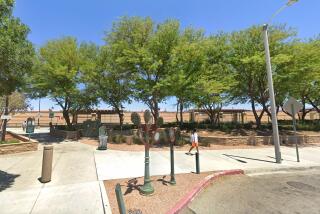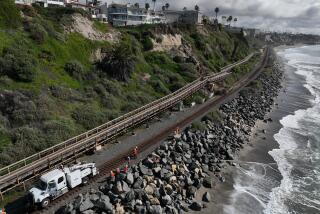Witnesses say light was green just before Metrolink train crashed

Three observers who say they were at the Chatsworth Metrolink station before last month’s deadly train crash have asserted in interviews that a final, crucial railroad signal was green as the commuter line’s engineer headed toward the collision point.
The accounts, including one from a station security guard and another from a retiree who says he was interviewed by a federal investigator, contradict a key preliminary finding by the National Transportation Safety Board.
The safety agency has said its evidence shows the signal was red when the Metrolink train, driven by engineer Robert M. Sanchez, barreled over a switch that merges two tracks into one and slammed into a Union Pacific train, leaving 25 dead and 135 injured.
Experts say it is common for investigators to get sharply differing witnesses’ accounts during inquiries into catastrophic accidents. But the three witnesses were insistent.
“I saw the light was green. Everything seemed all right,” said Chris Watson, 20, the station security guard. Watson said he was standing midway down the platform on Sept. 12 as Metrolink 111 pulled out of the station.
Bob Atkinson also said he saw the signal as the train departed.
“That light was green,” said Atkinson, 65, a retired movie projector repairman and train enthusiast who regularly visits the station and knew Sanchez. Another train buff, Chris Cassel, 56, said he was standing near Atkinson as they both looked down the track. “He had a full-blown green light when he left,” he said. All three were interviewed by The Times this week at the station.
If the track signal was green, it would raise the possibility that a combination of factors were at work in the deadliest train crash in modern California history. NTSB investigators said earlier this week that the engineer had sent and received cellphone text messages about the time of the crash. But could he also have received a false signal that the track ahead was clear?
An NTSB spokesman said Friday that he could not comment on the witnesses’ accounts. It was not clear whether federal investigators were pursuing or had ruled out the possibility that the light was green as Sanchez approached the fateful section of single, shared track.
“In many situations, witnesses will talk about diametrically opposed things,” said Barry M. Sweedler, who spent 30 years with the NTSB as an investigator and administrator. “Maybe if you spoke to three others, they would say the opposite.” But he also said he would consider the two rail enthusiasts to be more credible than an average observer because they’re familiar with rail operations.
Sweedler said the preliminary signal tests used to support investigators’ initial conclusions are “pretty reliable.”
In the days after the crash, investigators conducted three tests to check whether the signals were functioning properly.
The first was an electronic test of several signals before and after the Chatsworth station. The second was a “sight distance” survey that, among other things, checked whether Sanchez would have had a clear view of the signals. Investigators also examined computer data to see if the signals were working correctly on the day of the crash.
NTSB board member Kitty Higgins has said all the signals -- including two south of the Chatsworth station and one north of the station near the track switch mechanism -- were visible and working. Not only was the final signal red, Higgins said, but the light just before the station was solid yellow. “That indicates that the third signal is red, that you stop,” she said.
“We can say with confidence that the signal system was working,” Higgins said at a news conference after the tests.
NTSB officials have said a final test was planned to confirm that the two yellow signals and the red stop signal were all functioning properly. Results have not been announced.
The safety board also says that on the day of the crash, Sanchez sent and received dozens of text messages while on duty, including a final message 22 seconds before impact.
William Keppen, a former locomotive engineer and Maryland-based railroad consultant, said that false track signals can occur but that they are exceedingly rare. In 13 years as an engineer, he said he encountered false green signals twice, but did not proceed because he knew another train was on the tracks in front of him.
He noted that in the Sept. 12 Metrolink crash, the NTSB reported that the switch near the final signal was set so the freight train could move off the main track in front of the stopped Metrolink train. Normally, the switch and the track signals are coordinated, he said, which would also suggest Sanchez had a red light.
All sides, including the NTSB, agree that the signal is visible from the station platform, about a mile away. “We see it every day,” said Watson, the security guard. “I don’t wear glasses, and at 4:16 [Metrolink 111’s approximate arrival time] it’s pretty visible.”
Atkinson correctly identified the signal’s colors while being interviewed by a Times reporter.
On the day of the crash, he said, he was at the station when the Metrolink train pulled in, and after chatting with Sanchez about the Dodgers, he watched the train pull out. Because he’d been expecting to see a freight train coming from the north, he said, he looked up the tracks at the signal and saw that it was green.
“It’s a habit,” he said as he sat on a station bench this week. “We’re always curious about the freight train that comes through here.” Atkinson said he turned to Cassel and remarked, “I see a green light already. I guess he’ll [Sanchez] get through the tunnel first,” a reference to the single track passing through the mountains.
As it turned out, the freight was about to exit the tunnel and collide with the Metrolink train.
Cassel said he was at the station again a few days after the wreck when an NTSB investigator questioned Atkinson. When Atkinson told the investigator he had seen that the light was green the day of the accident, the investigator tested him on the signal’s colors and confirmed the 65-year-old could see the light, according to Cassel. He said the investigator thanked him but took no notes. Cassel and Atkinson said they did not get the investigator’s name.
“They asked me all kinds of questions,” including whether Sanchez had been using a cellphone, Atkinson said. He said he saw Sanchez using a train radio, but not a cellphone.
Though he knew Sanchez, Atkinson said he was not trying to protect the deceased engineer’s reputation.
“I’d just like to see what really happened,” he said. “I think somebody jumped the gun with all these theories” about text messaging.
molly.hennessy-fiske
@latimes.com
Times staff writer Dan Weikel contributed to this report.
More to Read
Start your day right
Sign up for Essential California for news, features and recommendations from the L.A. Times and beyond in your inbox six days a week.
You may occasionally receive promotional content from the Los Angeles Times.








